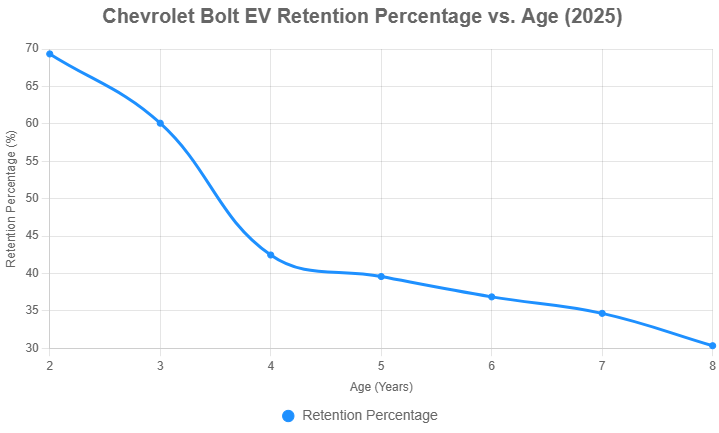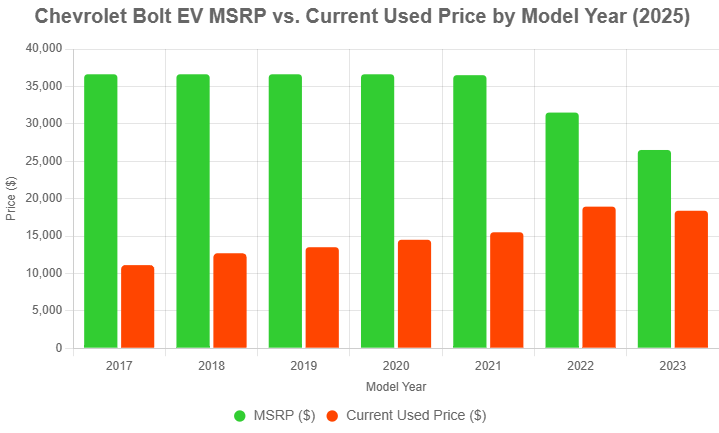Report is based on US data sources. (2017–2023 Models)
Introduction
The Chevrolet Bolt EV, launched in late 2016 for the 2017 model year, is a battery electric subcompact hatchback designed to offer affordable electric vehicle (EV) ownership. This report analyzes the depreciation of the Bolt EV from 2017 to 2023 model years, focusing on year-on-year trends based on Manufacturer’s Suggested Retail Price (MSRP) and current used prices as of June 2025. Data is sourced from the US market, specifically from Cars.com for MSRP and CarGurus for used prices. The report includes a table summarizing depreciation and visual representations (charts) to illustrate trends.
Depreciation Data
The following table presents the MSRP, current used price, age, and retention percentage for each model year of the Chevrolet Bolt EV.< Ascending
| Model Year | Age (Years) | MSRP ($) | Current Used Price ($) | Retention (%) |
|---|---|---|---|---|
| 2017 | 8 | 36,620 | 11,106 | 30.33 |
| 2018 | 7 | 36,620 | 12,693 | 34.66 |
| 2019 | 6 | 36,620 | 13,499 | 36.86 |
| 2020 | 5 | 36,620 | 14,494 | 39.58 |
| 2021 | 4 | 36,500 | 15,498 | 42.46 |
| 2022 | 3 | 31,500 | 18,924 | 60.08 |
| 2023 | 2 | 26,500 | 18,375 | 69.34 |
Visual Representations
To provide deeper insights into the depreciation trends, two charts are included:
- Retention Percentage vs. Age (Line Chart): Illustrates how the retention percentage (current used price as a percentage of MSRP) decreases as the vehicle ages.
- MSRP vs. Current Used Price (Bar Chart): Compares the MSRP and current used price for each model year, highlighting the depreciation gap.
Retention Percentage vs. Age

MSRP vs. Current Used Price

Analysis
Depreciation Trends
The data reveals significant depreciation across all model years, with older models experiencing greater value loss:
- The 2017 model, now 8 years old, has depreciated by approximately 70%, retaining only 30.33% of its original $36,620 MSRP.
- The 2023 model, only 2 years old, retains 69.34% of its $26,500 MSRP, reflecting both a lower initial price and less time for depreciation.
- The MSRP decreased notably in 2022 ($31,500) and 2023 ($26,500), likely due to market adjustments and loss of federal tax credits, as noted by Car and Driver.
General Depreciation Schedule
AS per further review of the Bolt on our site (EVDepreciation.com), a typical Bolt EV with an initial price of $34,018 follows this depreciation schedule:
- Year 1: 93.50% retention ($31,807, 12,000 miles)
- Year 2: 85.83% retention ($29,198, 24,000 miles)
- Year 3: 84.00% retention ($28,575, 36,000 miles)
- Year 4: 83.40% retention ($28,371, 48,000 miles)
- Year 5: 72.56% retention ($24,683, 60,000 miles)
However, actual retention percentages for specific model years (e.g., 39.58% for the 2020 model after 5 years) are lower than this schedule, possibly due to market conditions, battery recall issues in 2020–2021, or variations in trim and mileage.
Year-on-Year Trends
Detailed historical used prices for each model year at every age are scarce. However, specific examples from Kelley Blue Book provide some insight:
- 2017 Model (MSRP $37,495 for LT trim):
- 2022: $18,736 (49.95% retention)
- 2023: $15,336 (40.89% retention)
- 2024: $11,089 (29.57% retention)
- 2025: $8,546 (22.79% retention)
- 2022 Model (MSRP $31,500):
- 2023: $25,726 (81.67% retention)
- 2024: $18,156 (57.64% retention)
- 2025: $15,179 (48.19% retention)
These examples suggest that depreciation is most significant in the first few years, slowing as the vehicle ages, though EVs may depreciate faster than internal combustion engine vehicles due to technological advancements and market dynamics.
Limitations
- Historical used prices for each model year at specific ages are scarce, limiting precise year-on-year trends.
- Used prices are averages and may vary based on trim, mileage, condition, and regional market factors.
- The general depreciation schedule from EVDepreciation.com may not fully align with actual data due to specific market events (e.g., battery recalls).
Conclusion
The Chevrolet Bolt EV exhibits significant depreciation, with 2017 models retaining only 30.33% of their MSRP after 8 years, while 2023 models retain 69.34% after 2 years. The decline in MSRP for later models reflects market adjustments, but older models show greater absolute value loss due to age. The provided charts and table offer a clear view of these trends, though detailed year-on-year data is limited. This analysis underscores the rapid depreciation of EVs, potentially driven by technological advancements and market dynamics.
The Chevrolet Bolt EV, launched in late 2016 for the 2017 model year, is a battery electric subcompact hatchback designed to offer affordable electric vehicle (EV) ownership. This report analyzes the depreciation of the Bolt EV from 2017 to 2023 model years, focusing on year-on-year trends based on
Manufacturer’s Suggested Retail Price (MSRP) and current used prices as of June 2025. Data is sourcedfrom the US market, specifically from Cars.com for MSRP and CarGurus for used prices. The report includes a table summarizing depreciation and describes graphs illustrating trends, as requested.
